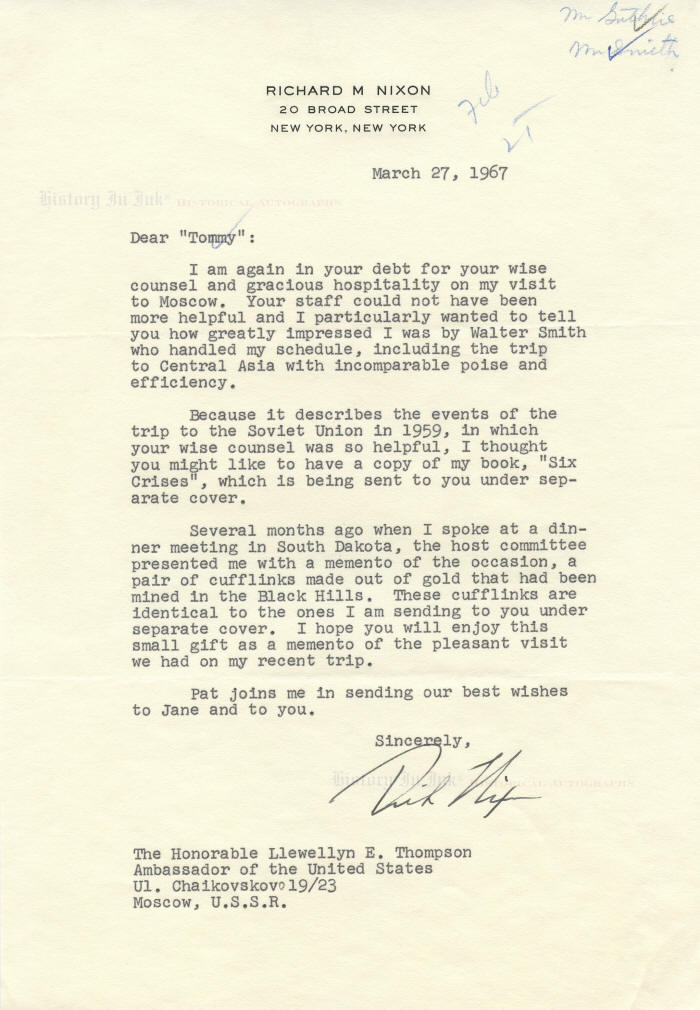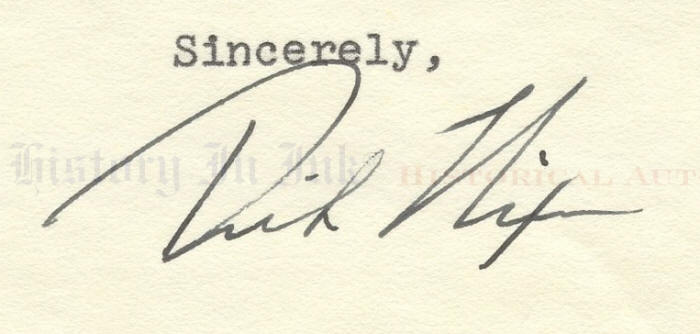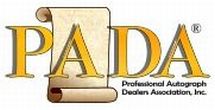

1403316
Richard M. Nixon
From the Estate of Llewellyn E. Thompson,
United States Ambassador to the Soviet Union
Nixon on his visit to the Soviet Union as he prepares to launch his 1968 campaign:
“I am again in your debt for your wise counsel and gracious hospitality on my visit to Moscow.”
Richard Milhous Nixon, 1913–1994. 37th President of the United States, 1969–1974. Typed Letter Signed, Dick Nixon, one page, 7¼” x 10½”, on personal stationery, New York, New York, March 27, 1967.
Nixon thanks Ambassador Thompson for his help during Nixon’s 1967 visit to Moscow, the first of four foreign trips that Nixon made as he prepared to seek the 1968 Republican presidential nomination. He writes, in full:
I am again in your debt for your wise counsel and gracious hospitality on my visit to Moscow. Your staff could not have been more helpful and I particularly wanted to tell you how greatly impressed I was by Walter Smith who handled my schedule, including the trip to Central Asia with incomparable poise and efficiency.
Because it describes the events of the trip to the Soviet Union in 1959, in which your wise counsel was so helpful, I thought you might like to have a copy of my book, “Six Crises”, which is being sent to you under separate cover.
Several months ago when I spoke at a dinner meeting in South Dakota, the host committee presented me with a memento of the occasion, a pair of cufflinks made out of gold that had been mined in the Black Hills. These cufflinks are identical to the ones I am sending to you under separate cover. I hope you will enjoy this small gift as a memento of the pleasant visit we had on my recent trip.
Pat joins me in sending our best wishes to Jane and to you.
Nixon campaigned hard for Republican candidates in the 1966 mid-term election. Two days before the election, he announced on Issues and Answers, a weekly ABC television news show, that he would take a “holiday from politics” for at least six months “with no political speeches scheduled whatever. What the future holds I don’t know.” But as Nixon described it in his memoirs, he “emerged from the campaign of 1966 as a seasoned senior Republican statesman who could still deliver some effective political licks.” Republican success in the election led him to announce that the results repudiated President Lyndon B. Johnson’s policies. While Nixon “wanted to run for President in 1968,” he remained officially undecided in order “to leave open, until the last possible moment, the option of deciding not to run.” Richard Nixon, RN: The Memoirs of Richard Nixon 278 (1978).
The Moscow trip was one of four “foreign study trips” that Nixon scheduled during his in the months before announcing his candidacy. He wanted, he wrote, “to bring my impressions up to date and to renew my contacts and refine my ideas about current conditions in the world.” His knowledge of foreign affairs, he thought, was his “political strong suit,” and the trips would help him “frame foreign policy issues in a way that would be both effective and responsible and, if I became President, to ensure that I could get a head start on what to me were the most important decisions a President faces.” Id. at 278-79.
Nixon visited Europe and the Soviet Union in March 1967. He followed with trips to Asia in April, Latin America in May, and Africa and the Middle East in June.
In this letter to Thompson, Nixon refers to “the events of the trip to the Soviet Union in 1959, in which your wise counsel was so helpful.” The reference is to Nixon’s trip as Vice President to open the American National Exhibition in Moscow, part of a cultural exchange between the United States and the Soviet Union. As the United States Ambassador to the Soviet Union, Thompson accompanied Nixon to open the exhibition. It was there that Nixon and Soviet Premier Nikita Khrushchev engaged in a series of impromptu hard-hitting ideological debates that covered the range of Soviet-American relations—the threat of atomic war, diplomacy by ultimatum, and economic progress. The most notable exchange, known as the “Kitchen Debate,” occurred in the model Betty Crocker kitchen. The volatile Khrushchev was impressed with Nixon’s tough mindedness and strong will. The debate did much to increase Nixon’s standing as a statesman and increase his chance of obtaining the 1960 presidential nomination. Khrushchev later said that he did everything he could to make Nixon lose, as he did, to John F. Kennedy in 1960.
As Nixon mentions in this letter, his first book Six Crises described the 1959 events in Moscow in a fascinating chapter simply entitled “Khrushchev.” Richard M. Nixon, Six Crises 235-91 (1962). New collectors, particularly, should be aware that the first edition of that book included a number of “autographed” copies that bear an Autopen facsimile of Nixon’s signature.
Llewellyn E. “Tommy” Thompson (1904–1972) was a career American diplomat who served at a critical time in history as the United States Ambassador to the Soviet Union under Presidents Dwight D. Eisenhower, John F. Kennedy, and Lyndon B Johnson. Thompson joined the Foreign Service in 1928, and during his long and distinguished career he served as the United States Ambassador to Austria from 1955 to 1957 before Eisenhower appointed him Ambassador to the Soviet Union in 1957. Kennedy reappointed him to Moscow in 1961. He resigned in 1962, but Johnson reappointed him in 1967, and he served until 1969. He also held the posts of Career Ambassador and Ambassador At Large. He was part of the Executive Committee to the National Security Council, or ExComm, which advised Kennedy during the Cuban Missile Crisis in October 1962, and he was present at Johnson’s summit with Soviet Premier Alexei Kosygin at Glassboro, New Jersey, in June 1967. After Nixon became President, Thompson came out of retirement to advise him on the Strategic Arms Limitation Treaty (SALT) negotiations with the Soviet Union and to serve as a member of the United States delegation to the SALT talks from 1969 until his death in 1972.
Nixon has signed this letter in black fountain pen. To acknowledge that he had read the letter, Thompson has made a checkmark and the initial “T” in blank upper right margin and added a checkmark over “Tommy” in salutation. There are also blue pencil notations “Mr. Guthrie,” “Mr. Smith,” and “File” for circulation and filing. The letter has two normal mailing folds and a slight crease at lower right corner. Overall the letter is in fine condition.
Provenance: This letter comes directly from the Thompson estate. It has never been offered on the autograph market before.
Unframed.
_____________
This item has been sold, but
click here to see other
Presidents and First Ladies items
that we are offering.



